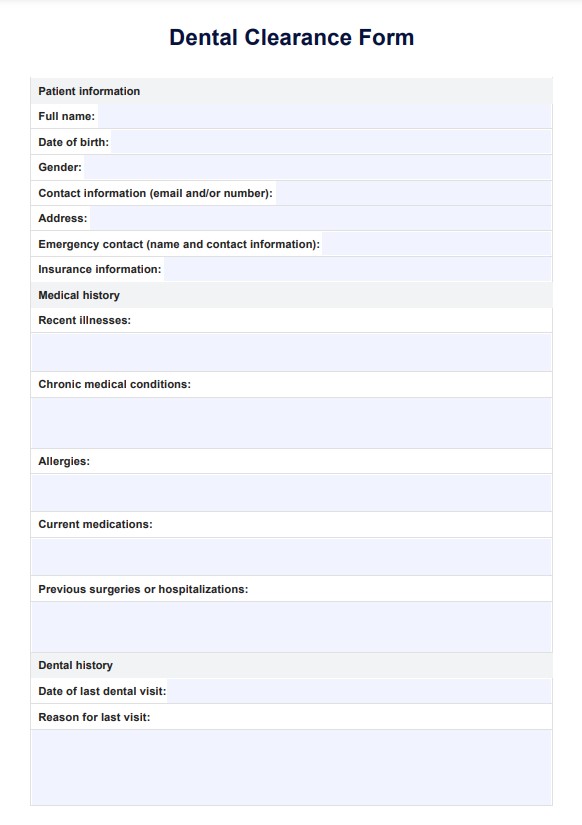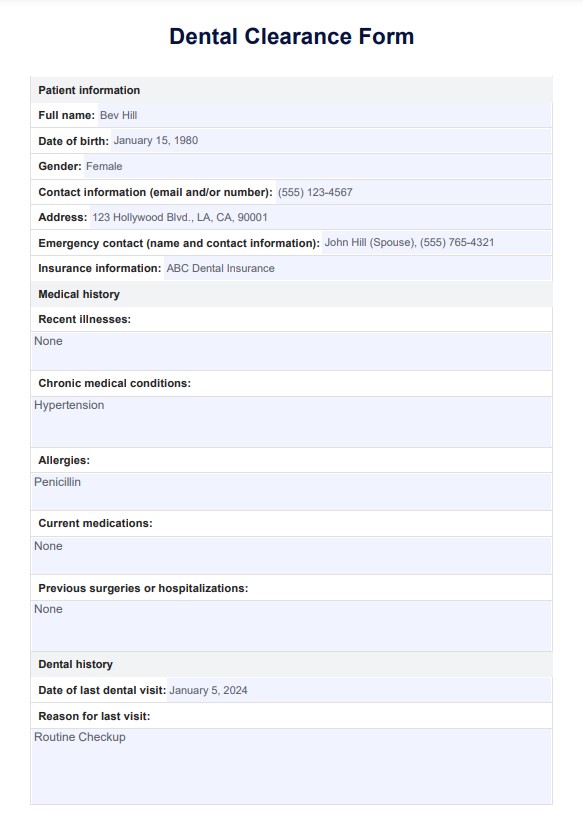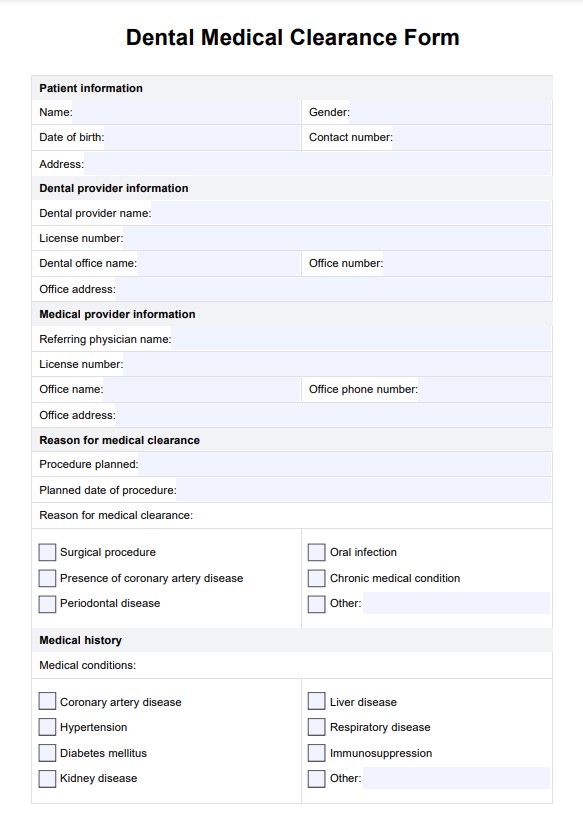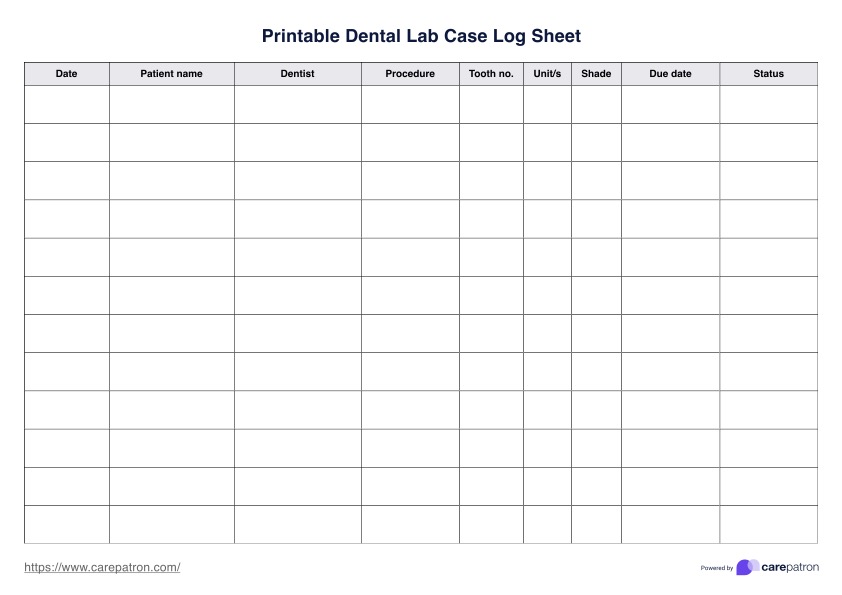Dental Clearance Form
Streamline your medical treatment process with our comprehensive dental clearance form. Ensure a smooth journey to treatment. Download now!


What is a Dental Clearance Form?
A Dental Clearance Form is a document that dentists, as well as oral and maxillofacial surgeons, use to get all the important details about a patient's teeth and health. It helps them decide if certain dental procedures are suited for them, especially if it’s something like surgery. It also helps the patient's dentist make smart choices for your safety and ensure their patient's dental treatment works well.
Beyond its administrative nature, a Dental Clearance Form can be an important tool for the patient's safety considerations. It provides a structured guide, allowing dental practitioners to document the patient's oral health precisely. The form is vital in delivering optimal dental care, emphasizing the importance of thoroughly understanding the patient’s health status for successful and safe dental treatments.
Dental Clearance Form Template
Dental Clearance Form Example
How to use this Dental Clearance Form template?
Ready to put this dental clearance template into use? Here's an easy-to-follow guide to help you get started:
Step 1: Download the template
To begin, download the printable Dental Clearance Form template from our website. This document collects crucial information about a patient’s dental and medical history, ensuring dentists can tailor treatments accordingly.
Step 2: Patient information
Fill in the patient's details accurately in the designated fields, including name, date of birth, contact number, address, emergency contact, and insurance details. This foundational information sets the stage for personalized dental care.
Step 3: Medical history
Enter information about the patient's medications, chronic medical conditions, allergies, recent illnesses, previous surgeries, and hospitalizations. A comprehensive medical history helps dentists evaluate potential health implications during dental procedures.
Step 4: Dental history
Provide details of the patient's dental history, such as the date of the last dental visit, the reason for the visit, previous dental issues, history of surgeries, dental habits, and any allergies to dental materials. This information aids dentists in understanding the patient's oral health background.
Step 5: Dental examination
Include the results of the dental examination, covering aspects like X-rays, oral health assessment, gum health, tooth decay, and existing dental restorations to determine the patient's current dental status. Identifying poor oral health is crucial, especially for patients with chronic conditions like renal disease, to ensure overall health and reduce complications.
Step 6: Additional information
Document smoking habits, alcohol consumption, dental habits, and any special instructions or considerations. This additional context provides a holistic view, helping dentists consider lifestyle factors in treatment planning.
Step 7: Dental clearance and recommendations
Based on the information provided, determine if they are cleared for surgery. If not, write down any recommendations you may have to get them surgery-ready.
Step 7: Dentist signature
The dentist will sign and write the date on the form upon completion. This step ensures accountability.
Step 8: Review and update
Encourage patients to review and update the form regularly, especially when their medical or dental history changes. Keeping information current is crucial for maintaining effective and personalized dental care.
When to request a dental clearance for medical treatment?
Requesting a Dental Clearance Form becomes integral in several scenarios as a crucial tool for practitioners across different healthcare settings. The form's utility is evident in various situations:
- Routine dental check-ups: Dentists, dental hygienists, and oral health professionals find the form valuable even during routine check-ups. It helps identify changes in a patient's health or medications that might impact dental treatments.
- Invasive dental treatment and pre-surgical evaluations: Oral surgeons and dentists performing surgeries or invasive dental treatment rely on the form. Before dental procedures involving surgery or extractions, it assists in assessing a patient's overall health and determining potential risks during the dental procedure or oral surgery.
- Patients with chronic medical conditions: The form is essential for dentists and dental healthcare providers when dealing with individuals with chronic medical conditions like heart disease who need to undergo procedures like cardiac valve replacement surgery. It aids in understanding specific considerations needed during dental treatments.
- Patients on medications affecting dental procedures: Dentists and dental professionals use the form when patients are on medications like anticoagulants or antibiotics. This allows for adjustments in treatment plans to ensure patient safety.
- Geriatric dentistry: The form benefits dentists specializing in geriatric care. Given the complex medical history often seen in elderly patients, it aids in understanding age-related health concerns and tailoring dental treatments accordingly.
- Pregnant patients: Dentists and oral healthcare providers use the form when dealing with pregnant patients. Pregnancy can influence dental health, and specific procedures may need modification. The form helps assess potential risks, ensuring safe and appropriate dental care for expectant mothers.
Benefits of using the Dental Clearance Form
Adding Dental Clearance Forms to dental routines isn't just about safety and communication—it's about ensuring treatments are just right, leading to success for both the patient and the dentist.
Enhanced patient safety
The Dental Clearance Form is crucial in keeping patients safe during certain dental procedures. It ensures that dentists can access critical medical info, especially if someone has conditions like coronary artery disease. This helps dentists decide if extra medical clearance is needed, ensuring safety during treatments.
Informed treatment decisions
These forms give dentists a good look at a patient's dental and medical history. This helps dentists choose which dental procedures are suitable for the person. For example, if someone is on anticoagulation therapy, the form helps the dentist plan treatments to avoid issues like excessive bleeding during tooth extractions.
Efficient communication with physicians
The Dental Clearance Form is a messenger between a patient's dentist and doctor. This is handy when medical treatments could affect dental health or vice versa. If a patient takes antibiotics for a health issue, the dentist can adjust dental treatments based on the form's information.
Prevention of infections
These forms alert dentists to any ongoing infections or possible need for antibiotics. This information is gold for dentists because it helps them determine the best way to handle dental procedures that might introduce bacteria into the bloodstream. This proactive approach helps prevent infections and keeps oral and overall health smooth.
Customized treatment planning
Dentists can use completed Dental Clearance Forms to plan treatments that fit each patient like a glove. This means considering the person's overall health, existing dental stuff, and whether they need local anesthetics or nitrous oxide. The form is like a blueprint for a treatment plan that follows the American Dental Association guidelines, ensuring each patient gets the necessary care.
Other helpful dentist resources
Carepatron, your go-to for dentist resources, provides valuable tools for dental professionals:
- Dental New Patient Form: Access our user-friendly template for efficient patient onboarding.
- Dental Treatment Consent Forms: Ensure informed consent with our customizable forms for transparent communication for every dental treatment.
- Dental Health History Form: Streamline patient assessments with a comprehensive form to gather medical information.
- Dental Treatment Plan: Optimize dental procedures using our template, enhancing communication and planning between dental teams and patients.
Commonly asked questions
Depending on your specific case, dental clearance may require additional documents, such as recent X-rays or medical records.
Dental clearance before surgery is necessary to assess and address any potential oral health issues that could pose risks during the surgical procedure.
The validity period of a Dental Clearance Form varies but is typically between six months to one year, depending on the healthcare provider's policy.















































































































